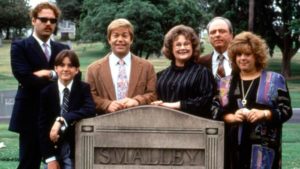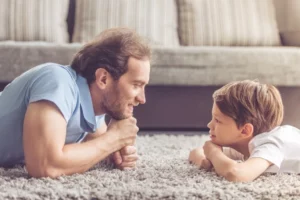Everything you Need to Know about Empathy~ To Have the Relationships You Long For
A surprising source of relationship WISDOM
The Story of Eli & Adi~
At three years old, my son, Eli saw his friend Adi crying when her finger got caught in a door. He reached out to hug her, but she said, “No”.
In EFT (Emotionally Focused Therapy), we refer to these moments as blocks.
Some adults, in Eli’s shoes, would have felt rejected and responded with anger and criticism or numb and withdrawal. (In EFT, we refer to these common reactions as “survival coping behaviors” or “protection“)
Some might have yelled, “How could you turn away from me?!” or in a stoic voice asked Adi 100’s of questions “to find out why you won’t let me hug you”.
Like a martial artist, Eli kept his emotional balance and focus on soothing his friend. He thought for a minute and then responded,
Adi, I want you to feel the love from my heart going to your heart.
At four years old, Adi heard Eli say that he was upset at the way she looked at him at the top of the slide at preschool.
Some adults, in Adi’s shoes, might have responded to his complaint (or feedback, another advanced skill) with defensiveness, counterattack, denial, or stonewalling.
Some might have told Eli that he was being ridiculous and ignored him the rest of the day, or yelled, “I wouldn’t have looked at you if you hadn’t…!”
Like a spiritual guru, Adi responded with an OPEN HEART by making an apology card with stickers 😉 saying simply,
Eli, I am sorry. Love, Adi
Not surprising, at age 11 now, they’re still good friends.
Young children are BIG SOULS on little legs (as minister Barry Ebert says) and have much to teach adults.

How do you measure the success of your relationship?
I suggest you consider…
how fast you can get back to LOVE after conflict…*Sometimes we can’t get back to love unless we acknowledge the hurt, pain and experience (of our partner/family member) to allow forgiveness to happen.
– Josh Reeves, Minister
How can you strengthen the key relationship skills that Adi and Eli demonstrated, get back to LOVE faster and have more successful relationships?
Empathy
Empathy is a natural and beautiful part of being human…
- Perhaps empathy is easiest for you with your children (who aren’t teens) or “fur babies”? Or, with your friends, co-workers, or peers in a social group?
- In these relationships, it’s easiest to give these loved ones the benefit of the doubt and see their challenging behavior as unintentional.
- Maybe empathy is hardest for you with your spouse/partner? Your parents and adult siblings? Your in-laws? A close friend? Or a different important, sacred relationship?
- In these relationships, it’s more challenging to keep your emotional balance and heart open during trying times.
Why is this?
Empathy is also an ADVANCED skill for adults!
Once we feel wounded by our *attachment figures- (or hear that our attachment figures are upset with us)… it requires a new mindset & lots of practice to be able to shift from our “protection” to:
- vulnerability & courage- in taking risks by expressing our pain (with emotion deeper than anger, stoicism & optimism, ex. fear & sadness) & attachment needs and longings.
- an open heart- to attune & empathize with our loved one’s pain & attachment needs.
And when BOTH loved ones are hurt… Someone has to be willing to go first!!!
This is where cultivating your emotional balance, willingness to put your relationship first (in order to eventually get your needs met) and listen with an open heart is essential.
This blog is valuable for:
- EVERY person who desires to strengthen their empathy muscle and RECEIVE more empathy from others. This process requires some “unlearning” for everyone (even “empaths” like me!) who want better relationships.
You will learn (or affirm):
- The #1 Obstacle to empathy in relationships & my top 3 solutions
- What empathy looks like~ in VIDEOS illustrating examples of the 3 different types of empathy, in addition to clarifying the origin & development of empathy (how Parents nurture or discourage emotional expression and empathy) ~ Empathy 101 (drawn from experts including Daniel Goleman and Paul Ekman)
- The most common obstacles (& solutions) that BLOCK this NATURAL process of empathy~ two people sending clear emotional signals (vulnerable emotions, needs and longings) and responding in a way that your loved one feels safe, seen, heard & cared for, which strengthens your bond. (This is the section with the “Star Trek” and “Friends” videos 😉
- How to strengthen your empathy or “attunement” skills (seeing/reading others’ emotions) and the most effective ways to listen, respond to & “co-regulate” your loved one. This skill set is especially helpful if you didn’t have empathy role models.
The #1 Obstacle to Empathy (for Adults) ~ Everyone believes they’re the “patient”, and no one wants to be the “paramedic”.

(This metaphor comes from James Hawkins, PhD, an EFT trainer.)
Here’s the STORY adults tell themselves that keeps them stuck in a negative cycle~
“MY PAIN is worse than your pain! You need to show empathy first.”
Or, “What you did to me was …. (fill in the blank) mean/insensitive, hurtful, etc. and YOU NEED TO CHANGE, but I didn’t do anything wrong and I don’t need to change.”
The #1 Solution to Increase Empathy (for Adults) ~ Take turns being the “patient”, and volunteer to be the first “paramedic” or the “Stronger, Wiser, Kinder Other”.
If adults in significant relationships– during KEY relational moments (when you or your partner/family member are expressing *attachment needs, fears or other vulnerable emotions & longings)- are able to…
- Carve out the time necessary to truly see, hear, feel and understand one another.
- Get grounded (calm your nervous system~ consider with your loved one’s help) in order to speak from and listen from your heart.
- (As the “paramedic”), Fully care for your loved one with empathy and get your partner/family member’s reassurance that they (“the “patient”) are ready to switch roles – before doing so…
Your relationship is likely thriving and has a secure bond, and you possibly don’t need to continue reading…
For the majority of us, we need to strengthen our empathy skills as vulnerability & emotional responsiveness are still fairly new relationship skills!
*What are attachment needs, fears and longings?
Examples of attachment needs & longings: deep acceptance (ability to fully reveal ALL of you), closeness, understanding, comfort, safety, seen as good enough, felt sense of security, appreciated, to know loved one is “there” for you & you can reach to them and trust they’ll respond to you (in general)
Examples of attachment fears: lack of safety and security, rejection, abandonment, not measuring up or even feeling like a failure, emotional deprivation/lonely, not being valued or accepted, unlovable
To make this paradigm shift of “patient” to “paramedic”~
I recommend that couples (& family members) read one or more books written by Dr. Stan Tatkin (ex. Wired for Love) who created PACT couples therapy, and/or one of Dr. Sue Johnson’s brilliant books (ex. Lovesense or Hold me tight).
When I find an attachment theory book written specifically for families of adult children, I will add it to this list! (in the meantime, consider the workshop, “Hold Me Tight, Let Me Be Me”). Also, the concepts below are still incredibly valuable to Parent-Adult Child relationships since both adults (parent and child) need to demonstrate A.R.E. and “secure functioning” behaviors, just not totally reciprocally and Parents need to take the lead.
In the EFT (Emotionally Focused Therapy) model, families and couples learn how to be more A.R.E. (accessible, responsive and engaged).
The examples below of A.R.E. are from the Hold me tight book by Sue Johnson, PhD.
Accessibility examples:
- “I can get my partner’s attention easily.”
- “I am not feeling lonely or shut out in this relationship.”
Responsiveness examples:
- “If I need connection or comfort, my partner will be there me.”
- “If I need reassurance about how important I am to my partner, I can get it.”
Engaged examples:
- “I can confide in my partner.”
- “I know that my partner cares about my joys, hurts, and fears.”
- “I feel safe enough to take emotional risks with my partner.”
Sue Johnson underscores the importance of A.R.E. throughout our lifetime and that it is the KEY to a lifetime of love~
From cradle to grave, we need to know we matter to the ones we love and that when we cry out in distress, someone will come to comfort us.
In the PACT model, couples are encouraged to create a service-oriented, reciprocal (or EQUAL) relationship (that can be adapted to family relationships) in which each partner commits to doing everything possible to help their partner feel SAFE, SECURE and LOVED (elements of a “secure functioning relationship”).
This requires being committed to learning your loved one’s “owner’s manual”– what contributes to your partner/family member to feel safe and unsafe, secure and insecure, loved and unloved (& following their owner’s manual as much as possible). Similar to following your car’s owner’s manual, this “loved one’s manual” is as important if you care about your relationship’s success (& your loved one!)
It truly is a paradigm shift for most adults… that to receive empathy, we need to give it. (*We also need to take emotional risks in letting ourselves be seen.)
Somehow many of us have come to BELIEVE that our partner (or family member) should just KNOW what we’re feeling, thinking and needing (without us vulnerably and courageously speaking from our heart), yet we feel we should be given grace for not being able to do the same for our partner/family member.
#2 Solution to Increase Empathy (for Adults) ~ Let your loved one’s emotions move you. FEEL them and reflect them. (This is empathy.)
Empathy takes us out of feeling ALONE in our pain. This is profoundly “regulating” (calming).
Sometimes the MOST powerful healing response is the SIMPLEST one.
Example 1.) My husband and I attended a “Hold Me Tight” couples retreat many years ago. The workshop leaders take couples through the 7 Bonding Conversations from the book.
When we got to Conversation 5- “Forgiving Injuries”, each partner is instructed to share a hurt that is NOT yet resolved. I brought up a situation that my spouse and I had discussed on several occasions, but it wasn’t healed because I didn’t yet have a “felt sense” that he really got my pain, nor did I receive his reassurance that he would do everything possible to have my back (regarding this issue) in the future.
This conversation was a HUGE turning point for our relationship …
Since my spouse not only repeatedly expressed genuine remorse, he also wept in response to me retelling the story of my pain. It was ONLY when he allowed himself to fully feel and reflect my pain was I able to let it go and know in my bones that he got it and would have my back in similar future situations, which is exactly what came to pass.
The research on healing from attachment injuries is very clear-
When the hurt party sees their pain reflected in their partner’s eyes, they can finally let it go and heal.
Example 2.) A newcomer introduced himself at my Al-Anon meeting.
When he got up the courage to share his story, I made sure to make friendly eye contact with him since he appeared nervous. Then, I mirrored his emotions (with my face) throughout his story.
At the end of the meeting, he walked over to tell me how much he appreciated how I “completely understood” him. I had NOT said a single word to him during the meeting. All I did was mirror his emotions.
Example 3.) I will ALWAYS remember and cherish my childhood town’s veterinarian because of the most caring way he responded when I was consumed by grief and guilt after having one of my dog’s euthanized.
Even though the animal hospital staff told me clearly that our dog’s lungs were filled with cancer, I still had that agonizing doubt that I made the right decision. So, on the way home from the hospital, I stopped at the vet’s office, and Dr. Lavitt came out to meet with me (without an appointment).
He could have just offered me factual medical information as reassurance of my decision. Thankfully, he knew what my heart needed~ After he briefly confirmed my dog’s incurable illness, Dr. Lavitt allowed his eyes to well up with tears too.
Emotional distress often needs an emotional response to be soothed.
Remember~
- If you want to genuinely convey “I’m with you”, “I get you”, you have to “feel with” your loved ones by clearly reflecting and matching their non-verbal body language. Words alone (with no emotion) often fall flat because they don’t feel genuine.
- Reflecting emotions~ allows for more healing & bonding than your most articulate insight, and by far more connection than your most intelligent “logical solution”.
The #3 Solution to Increase Empathy (for Adults) ~ Learn the 3 “P’s” of Relationships so You Can CHANGE Your Cycle!
(EFT Trainer, Ryan Rana, PhD explains the 3 “P’s” in his trainings.)
Pain- In order to empathize/emotionally respond in the most comforting way, we must know our loved one’s pain.
Ask yourself~
- Do I REALLY understand my loved one’s pain?
- Do I genuinely get what is triggering them?
- Do I accurately know what they’re feeling and thinking in these moments when our cycle has taken over our relationship?
Protection- We ALL do this because it’s how we survive, and “protective coping moves” block empathy & vulnerability.
Ask yourself~
- Can I *clearly identify my protective moves that FEED or CO-CREATE the cycle? (some form of fight, flight, freeze, hide, or please) *Behaviors that anyone can SEE on video.
- The CHALLENGE is being AWARE of our moves and HUMBLE and OPEN to hearing what other’s see our moves are, Ex. fight = anger/criticism/defensiveness/talking about your partner or flee/hide = dismiss or deny any issues, exit emotion into logic/problem solving, get very still & quiet, change the subject, be overly positive, etc.
- Do I understand the FUNCTION (purpose/ hope/ good intentions) of my protective moves & even more IMPORTANTLY the function of my PARTNER’s moves?
- Can I see how my moves UNINTENTIONALLY trigger my partner’s vulnerability (cause them to feel UNSAFE, all alone/unimportant OR to feel like they can never get it right/make us happy)?
ImPact on our Partner (or family member)~ how the cycle blocks empathy & causes conflict & disconnection
Ask yourself~
- Do I understand the impact of my PROTECTIVE MOVES on my loved one?
- Can I see the bigger picture of how MY moves influence my partner’s moves (& vice versa)? BOTH you and your loved one are VICTIMS & AUTHORS of your cycle. Can I fill in the blanks:
“The more I…, the more you… until we are BOTH caught in the cycle.”
- In EFT, we know that once loved ones are fully aware of their cycle, motivated to alter their protective moves (to experience the closeness & bond they long for), they can more consciously stop it by~
Choosing to take risks with their hearts
Watch/listen to a few empathy (video) examples~
Notice that there are many different ways to show empathy! There is no one right way that fits all people and situations. I hope to update this list of video clips as I find better examples…
“Get Service” – (4 min) This is a MUST see video for ALL individuals who want to RECEIVE more empathy. You must FIRST put yourself in the shoes of your loved ones & understand THEIR pain.
Be kind, for everyone you meet is fighting a hard battle
Notice how subtle, yet powerful empathy can be in realistic examples (1 & 2) & in real life (3):
1.) Emily Mortimer & Paul Schneider (1 min, 40 sec) in “Lars and the Real Girl”. Paul’s willingness to show his vulnerable sadness and pull his wife in closer for a full hug and Emily’s attunement and responsiveness allows her to be empathetic and comfort Paul. (This illustrates how this is a “dance”.)
2.) Helen Hunt (2 min) – forgives her mother for her emotional neglect & alcoholism in “Pay it Forward”.
3.) Mary Amato’s Story (5 min) – about her “Unsung Hero” who reframed her identity as a SAHM. The episodes in this podcast are all 3-5 min. examples of compassionate empathy to lift your spirit.
Two more examples that are more dramatic…
4.) Jim Redmond (2 min) – supports his adult son at his greatest moment of need. By not leaving his son alone in (physical & emotional) anguish, and instead choosing to be by his side, this transforms trauma into a powerful loving & bonding experience.
5.) Somali, (10 min) – freedom fighter, healer & owner of a Children’s Safe House in Cambodia (for children who are survivors of sex trafficking (Clips of Somali @ 6:43, 7:48, 9:28 and for her full amazing story, see the documentary, “Half the Sky” or read the book. Somali cries with her girls, helps them heal through love and empowerment, and risks her life to free more children.
Finally, the ONLY example that clearly shows all 3 forms of empathy (cognitive, emotional & compassionate)
Antwon King Lee (3 min) comforts his baby boy as his son gets his first vaccination shots.
~ This is the ONLY example of a man demonstrating cognitive, emotional and compassionate empathy! Other descriptions of this father’s empathy are “emotional resonance” & “attunement”. This type of empathy requires the most practice and skill, and some people are naturals.
What emotions did you experience? Which video is your favorite? Which empathy skills did you notice?
Can you recommend any video clips of empathy? If so, please email: [email protected]
For more empathy video examples, information & skills- check out my blog:
“Men CAN do empathy too! Here’s how…“
Empathy 101
3 Different Types of Empathy (Ekman & Goleman)
1.) Cognitive Empathy (or emotional & thought recognition)– knowing what the other person feels and what they might be thinking; perspective-taking. [This is a step beyond problem solving.]
- This skill is an asset in negotiation or in motivating people, especially for managers at work. Personally, it feels good to hear someone accurately reflect our thoughts and feelings. And I think many individuals believe that this skill alone demonstrates that they “get” another person because their words can sound like they really do.
- However, their behaviors & non-verbal body language reveal that this level of empathy is often too much on the surface to have a deeper impact. Keeping cool in a crisis (or in the midst of your loved one’s big emotions) signals misattunement and can lead to detachment and apathy. Even if it leads to some helpful action, the person in distress won’t feel seen, heard, soothed or cared for.
Example~ I recently spotted a LARGE SNAKE on my descent on a hiking trail and stopped in my tracks to try to figure out how I was going to get down the trail. I saw a cyclist heading down as well and waved him over. I appreciated having his company (not being in my distress alone) and he did understand my thoughts and feelings about the situation, but he showed NO emotions (on the outside) other than intellectual curiosity about the snake 😉 While I was grateful to have another person who understood me, that was it. Consequently, I don’t remember anything about him since it requires emotional vulnerability and emotional responsiveness to form a bond or at least a memory.
2.) Emotional Empathy (or emotional resonance)– feeling what the other person feels because we’re attuned to another person’s inner emotional world. We allow ourselves to be MOVED by another person’s emotion, which reflects to another person, “I feel you. You’re not alone in your pain (or joy).”
- Ekman says, “People LOVE others who resonate with them.” (Resonating is the experience of feeling seen, heard, understood and cared for; connecting with your hearts)
- Emotional resonance has an enormous calming effect since we are wired to connect, and ALL humans (from cradle to grave) find comfort in deep connection and “co-regulation” by others (unless we’ve experienced abuse or emotional neglect of our feelings that blocks this natural survival instinct of sending a clear vulnerable emotional signal & feeling “felt” & responded to).
- This skill is a professional strength in careers from sales to nursing. However, Ekman warns:
In a state of emotional empathy, (especially for first responders) people sometimes lack the ability to manage their own distressing emotions, which can lead to paralysis and psychological exhaustion. Medical professionals often inoculate themselves against this kind of burnout by developing a sense of detachment from their patients.
- The goal for these professionals AND in your personal life is well-calibrated caring to avoid burnout, yet not lose this amazing skill that sends a clear signal to others about your love & care.
Example~ I will ALWAYS remember and cherish my childhood town’s veterinarian because of the way he responded when I was consumed by grief and guilt after having one of my dog’s euthanized. Even though the animal hospital staff told me clearly that our dog’s lungs were filled with cancer, I still had that agonizing doubt that I made the right decision. So, on the way home from the hospital, I stopped at the vet’s office and Dr. Lavitt came out to meet with me (without an appointment) and not only did he confirm the hospital’s prognosis and reassured me that we made the best decision for our dog, his eyes also filled up with tears.
3.) Compassionate Empathy– We not only understand a person’s predicament and feel their vulnerable emotions with them, we are also spontaneously moved to help if needed. Ekman explains this is propelled by the belief that “WE’RE ALL CONNECTED”.
- This can also lead to outbursts of “constructive anger”. For example, reacting negatively to injustice or suffering can motivate us to work with others to make the world a better place.
- Ekman distinguishes between four different types of compassion~ familial, global, sentient, & heroic in this article. The example below is of heroic compassion.
Example~ Dr. Jeff Brodsky (Conifer, CO) has lived barefoot for 13 years. In 2010, he and a colleague were in Cambodia feeding a meal to children who lived in and near the garbage dump. They were also looking for children who were at high risk of being taken by predators and sold into brothels. He noticed almost all the children were barefoot. Dr. Jeff decided to live in solidarity with these children and even though it can be very difficult living barefoot, he believes it’s worth it if he can motivate one person to action to rescue one more child a year. Dr. Jeff wrote a powerful memoir called The least of these that tells his journey to this heroic work including his undercover rescue missions.
He eventually founded an organization called Joy International whose mission is dedicated to the prevention of child trafficking and to the freedom, healing and empowerment of trafficked children, teens and young adults worldwide. Jeff’s compassionate empathy has inspired others to take action as well through a variety of events including the Barefoot Mile Walks.
Origins of Empathy
If your learning style is experiential, try this POWERFUL EXERCISE I will guide you through in this video from 2:41 to 15:18 (just 13 min). Click on the video link below & skip to 2:41.
Video Link: How we Learn (or don’t learn) Empathy within our Family
Caveats: This video’s focus is on empathy within our families (or “familial compassion”) as shown between caregivers and children & later between intimate adult partners.
You may have learned the value of “global, sentient and/or heroic compassionate empathy” as described by Paul Ekman (see above in “3 Types of Empathy”) through your parents’ work, community service, charitable giving, etc. Learning any form of empathy in your family is invaluable, and Ekman has found that most adults can cultivate the skill of empathy at any point in their life.
Also, although I don’t use the word empathy in this video, it is very similar to the skills of:
- attunement (the ability to read and feel other’s emotions & understand what they’re thinking)
- responsiveness (the ability to “mirror” non-verbally & verbally, comfort, provide care, support, validate &/or just provide your presence so your loved is not alone in pain).
Video summary~
The skills of “attunement” and “responsiveness” are not reflective of loving or not loving our significant others.
Even just 2-3 generations ago, there were different societal expectations of parents and spouses. Ideally, every generation does better with more accurate relationship information, so we can all experience feeling safe, seen, heard & responded to = strong, secure bonds.
When we can trust our earliest attachment figures to be safe and reliable caregivers of our emotional and physical needs, we will likely develop a relational coping style (be in touch with and communicate our inner world (even if it feels risky)- and attune and respond to our intimate partner.)
On the other hand, if one or both of our parents/guardians were inconsistent or not safe, unreliable or were safe and reliable regarding our physical needs, but dismissive of our emotional needs, we will likely develop an individual coping style (turn to “substitute attachments” to meet our needs and decrease our connection with our inner world &/or send scrambled signals (ex. anger instead of fear) and have less ability to attune and respond to our partner).
Developing a relational coping style (essential for a secure bond) is possible!
If you didn’t experience this as a child, it will require some healing, openness (to taking risks & challenging your anxious or dismissive thoughts) and willingness to practice sending clear vulnerable signals to get your needs met and learning new skills (attunement & responsiveness/empathy) to meet your partner’s needs.
Most couples with one or both partners who didn’t experience a secure bond with their early attachment figures need the support and guidance provided in couples therapy and/or a couples workshop to develop “a new attachment dance”. To schedule a free consultation, click here for my calendar.
Empathy begins ~ virtually from the day we’re born!
(from “The Roots of Empathy” in Daniel Goleman’s book, Emotional intelligence)
Infants, just a few months old, react to a disturbance in those around them as though it were their own, crying when they see another child’s tears.
At a year old, children start to realize the misery is not their own, though they are confused over what to do about it. In research by Martin L. Hoffman, a one year old brought his own mother over to comfort a crying friend, ignoring the friend’s mother, who was also in the room.
At around two and a half years, toddlers realize more clearly that someone else’s pain is different from their own, and are better able to comfort them… A typical incident, from a mother’s diary: ‘A neighbor’s baby cries… and Jenny (toddler) tries to give him cookies, stroke his hair, brings him toys and pats his head and shoulders.’
Toddlerhood is also the age when children “begin to diverge from one another in their overall sensitivity to other people’s emotional upsets, with some keenly aware and others tuning out”.
By late childhood, the most advanced level of empathy emerges, as children are able to understand distress beyond the immediate situation… At this point they can feel for the plight of an entire group… That understanding, in adolescence, can buttress moral convictions centered on wanting to alleviate misfortune and injustice.
What explains this divergence between some children and later adults developing advanced levels of empathy while others seem unresponsive and insensitive to people’s pain?
How do we learn empathy?
Why do we see empathy demonstrated more selectively by adults?
Factors that nurture empathy (or indifference) in children
1.) Parents’ level of attunement to their baby (Psychiatrist, Daniel Stern’s research)~ Stern discovered that the most important lessons of emotional life are laid down in the small, repeated exchanges between parents and their children. He studied this with microscopic precision through videotaping hours of mothers with their infants.
Of all such moments, the most critical are those that let the child know their emotions are met with empathy, accepted and reciprocated, in a process Stern called attunement.
Through attunement, mothers let their infants know they have a sense of what the infant is feeling. For example, a baby squeals with delight and the mother affirms that delight by cooing or matching the pitch of her voice to the baby’s squeal. Such small attunements give the infant the reassuring feeling of being emotionally connected.
Attunement is very different from simple imitation. Imitation only shows you know what the baby did. Attunement lets the baby sense you know how he feels.
At around 8 months, from repeated attunements, an infant begins to develop a sense that other people can and will share in their feelings.
The countlessly repeated moments of attunement or misattunement between parent and child shape the emotional expectations adults bring to their close relationships– perhaps far more than the more dramatic events of childhood.
The Costs of Misattunement (Stern)
When parents are [repeatedly] misattuned to a child, it is deeply upsetting. Prolonged absence of attunement between parent and child takes a tremendous toll on the child.
When a parent consistently fails to show any empathy with a particular range of emotion in the child- joys, tears, [fears] needing to cuddle- the child begins to AVOID expressing and perhaps even feeling those same emotions.
In this way, presumably, entire ranges of emotion can begin to be obliterated from the repertoire for intimate relations, especially if through childhood those feelings continue to be covertly or overtly discouraged.
By the same token, children can come to favor an unfortunate range of emotion, depending on which moods are reciprocated. (for example, infants mirror their parents’ anger or depression)
A study of criminals, who committed the cruelest and most violent crimes, found a common characteristic from their early lives- emotional neglect and little opportunity for attunement.
Through reparative relationships, there is hope!
Relationships throughout life- with friends and relatives- continually shape your working model of relationships. An imbalance at one point can be corrected later [if you’re willing to do the internal work]; it’s an ongoing, lifelong process.
Therapy can even provide an emotionally corrective experience! When a therapist mirrors a client (reflects back an understanding of their inner state) just as an attuned parent does with their infant, a client can experience a sense of being deeply seen and understood. This emotional synchrony is unstated and often outside conscious awareness.
Other Factors that Shape Empathy (or Indifference in Children)~
2.) Parents’ reaction to another person who is distressed ~ Children imitate what they see and [ideally] develop a repertoire of empathic responses from watching their parents help other people who are in distress. There are an infinite number of ways parents can MODEL empathy in their home, local community and beyond borders through attunement with others and compassionate actions.
3.) Parents’ discipline style– specifically whether or not parents solely focus on their child’s behavior being “good” or “bad” (does not lead to empathy) or parents focus on the impact their child’s behavior has on others’ emotions (nurtured empathy). (Research from Radke-Yarrow & Zahn-Waxler)
4.) Other significant adults in a child’s life can also cultivate empathy by providing corrective healing experiences, such as attunement, showing curiosity and genuine interest in a child’s inner world and responding with empathy and comfort and modeling empathy with others.
I’m sure there are many more factors that instill empathy in children, and will probably be adding to this list in time. Please email me at [email protected] if you have one I should add to this list. Thanks!
Don’t despair if your childhood did not reflect some of the elements above that nurture empathy.
Unexpected gifts can come from painful childhoods.
It is actually common for adults who experienced abuse to have the GIFT of sensing what others around them are feeling.
Emotions and empathy are a part of our biology and you can reconnect with both if you’re willing to do the work.

Another video to check out is the powerful “Lovesense” (11 minutes) which illustrates the 3 steps in the “attachment” dance that both builds a secure bond and reflects its strength:
- Connect or Attune (empathize)
- Disconnect or Misattune (or rupture- looks like indifference or attacking)
- Reconnect or Repair (attune/connect again) ~ Couples and family therapists know this step requires empathy & is THE most important step in this natural process.
No two people are always going to be in synchrony and harmony. Openness and willingness to be empathetic, humble and repair (which might include an apology) is essential in ALL relationships.
Empathy is our true nature.
If you disagree, I encourage you to go to a playground and observe for a few hours…
If you see a child experiencing acceptance, belonging, comfort and safety and especially attunement (parent is in synch and responding to their child’s emotion in general… No parent or partner can do this 100% of the time), you’ll likely see a child demonstrating empathy as well.

If this does not describe your childhood at all, don’t despair or feel that you have to protect your parents! There are 1,000s of ways to love a child and not all parents learned the skills above (or know the value of them).
As I mention in my other blog, “Men CAN do empathy too! Here’s how…”, because our culture historically rewarded people more for their problem solving skills and valued performance, accomplishment and self-reliance over relationships, nurturing, & emotional intelligence, it is quite possible that empathy was not modeled or taught in your family. Thus, it might not feel natural at all.
Whether or not you cultivated empathy in your family of origin and/or your efforts in being empathetic are successful or unsuccessful in your adult intimate relationship~
Below are the skills & information you need (+ experiential practice) to identify the blocks to your innate empathic nature and learn new empathy practices to have the relationships you long for!

What gets in the way (for adults) of our NATURAL EMPATHY or EMOTIONAL RESPONSIVENESS? (Most common blocks & solutions)
 Sending scrambled signals with a still face – Trying to conceal all emotions and act like a VULCAN from Star Trek, but expecting others to respond to you with empathy. Here’s a VIDEO example called “Emotionally Compromised”.
Sending scrambled signals with a still face – Trying to conceal all emotions and act like a VULCAN from Star Trek, but expecting others to respond to you with empathy. Here’s a VIDEO example called “Emotionally Compromised”.
 Sending scrambled signals with an ANGRY face – Instead of expressing the underlying emotions (ex. sadness, fear, hurt) or a longing for closeness, scaring your loved ones with ANGER, threats, blame, and shame and expecting others to respond to you with empathy. Here’s a VIDEO example in this clip from the movie, “The Breakup”. (Jennifer Aniston’s character)
Sending scrambled signals with an ANGRY face – Instead of expressing the underlying emotions (ex. sadness, fear, hurt) or a longing for closeness, scaring your loved ones with ANGER, threats, blame, and shame and expecting others to respond to you with empathy. Here’s a VIDEO example in this clip from the movie, “The Breakup”. (Jennifer Aniston’s character)
-
Believing the TOXIC “story” we’re telling ourself about our relationship and/or partner or family member.
To increase our empathy, it’s critical to ask yourself…
- Is my thought the truth or a story I’m telling myself? Am I using my M.S.U. degree?! (Making Stuff Up!)
- Is my thought engendering empathy, contempt, indifference, or something else? And when I believe this thought, what do I feel? And which behaviors do I tend to do? Lastly, how does THIS thought IMPACT my personal well-being and my relationships?
- A brilliant healer named Byron Katie has 4 “liberating” questions that have helped transform many people’s lives. Here’s a brief article about how to use this tool.
One of the best tools I’ve learned is to question my thoughts. This allows me to be more centered, clear, humble and open-minded and open-hearted.
The phrase that’s become a lifesaver in my marriage, parenting and professional life:
“The story I’m making up is …”
~ Brene Brown, PhD
To learn more about this technique, read Brown’s article, “How to reckon with emotion and change your narrative”.
4. Lack of modeling and experiencing empathy & responsiveness in our family of origin.

Do the POWERFUL exercise in the VIDEO, “How we learn (or don’t learn) empathy within our family” ~ I will guide you through it in this video from 2:41 to 15:18 (just 13 min). Click on the video link above & skip to 2:41. (More info in “Origins of Empathy”)
If (in the exercise) you recalled one or both of your Parents…
a. Underresponding to your emotions (ex. minimized, ridiculed, got logical or didn’t respond consistently)
b. Overresponding to your distress (ex. angry, more upset than you, went over the top)
c. Or, if you are convinced that your Parents were there for you emotionally, but you have no specific memories of you feeling sad, scared, lonely or hurt & how they specifically comforted you…
You will likely have some difficulties in this “empathy” or attachment dance caused by your struggle to send clear, vulnerable signals to your intimate partner about your emotions, needs and longings and/or respond to your partner in an empathetic manner.
The HOPEFUL news is that you can strengthen this muscle through LOTS of reps!
This work is worth it since it leads to you both feeling more seen, heard, cared for and responded to~ the basis for a secure bond.
5.  Shame – can block empathy if an individual struggles with admitting that they could ever make a mistake. If you grew up in a home in which you never witnessed your caregiver’s vulnerability, for example they never admitted to a human error and never apologized, or if you experienced or witnessed harsh punishment for mistakes, it makes sense that it would be extremely distressing to hear criticism from your partner (or even vulnerable needs/longings) and it would be difficult to know how to respond.
Shame – can block empathy if an individual struggles with admitting that they could ever make a mistake. If you grew up in a home in which you never witnessed your caregiver’s vulnerability, for example they never admitted to a human error and never apologized, or if you experienced or witnessed harsh punishment for mistakes, it makes sense that it would be extremely distressing to hear criticism from your partner (or even vulnerable needs/longings) and it would be difficult to know how to respond.
Being consumed with the fear that if you admit to your shortcomings, you’ll be seen as less than, rejected, abused, disrespected, or something else can cause some folks to hide or check out emotionally and others to double down and blame/counterattack. Fear and shame can cause some folks to struggle to be open and present to your loved one’s emotions and needs.
As hard as it may sound, your courageous openness to receive feedback, take turns with your loved one in showing empathy and bravely taking risks in being vulnerable will allow you to finally receive the VERY empathy (attunement & responsiveness) that you deserved as a child and still do as an adult.
6. Having a diagnosis on the Autism spectrum (or formerly diagnosed with Aspergers)
Often these adults struggle to accurately identify other folks’ emotions (due to their condition), which makes effective emotional responsiveness – with people they love- near impossible.
Fortunately, Dr. Paul Ekman (an expert on micro-expressions) has an online class that has shown that folks on the spectrum can get up to speed in emotion recognition in less than one hour! Here is a link to Ekman’s classes that range from basic to advanced skills in identifying micro-expressions of emotions. Fyi- one of my therapist colleagues (who is not on the spectrum) took this class and said he learned a LOT too!
7. Empathy sounds so simple… until the “cycle” takes over.
In personal relationships, EVERYONE wants to RECEIVE empathy, yet stop giving it when they’re caught in negative cycles because we see ourselves as the “victim” & our family member or partner as “the bad guy”.

The negative cycle is the biggest block of all….
I’m right, you’re wrong!
This is fact, logic, the truth. (except that relationships involve our heart- needs, longings and struggles)
I’m kind, you’re mean!
I’m innocent/the hurt party, you need to change!
I’ve done MY personal/spiritual work, but you haven’t..!
For more information about the “Cycle”, see my other blog called, “Transform your vicious cycle into positive loving connection”.
When loved one’s get stuck in their negative cycle of conflict or distance, it’s not due to a lack of LOVE…
It’s a pattern of scrambled signals and a lack of EMPATHY.
BOTH loved ones need to change in order to have the relationship they long for.
EFT trainer, Michael Barnet has found that:
Couples [& family members] unintentionally co-create a toxic pattern that maintains relational distress and erodes trust and closeness. Partners are both unwitting victims and authors of their “cycle”.
How to strengthen your empathy or “attunement” skills
1.) Take turns putting yourself behind the desk of the “Empathy Department” (vs. complaint department) to solely focus on understanding & showing empathy.
- Use the acronym~ M.O.V.E. (closer to the one you love 🙂 [drawn from Harville Hendrix and Terry Real]
Mirror the words you’re hearing (paraphrase the story & repeat back some of the key words) and the emotions your loved one is expressing or you feel inside, & sometimes non-verbal body language.
Open your heart and mind (before, during and after the talk)- breathe & meditate before a hard talk & trust that the more open & curious you are, the more your loved one will feel heard and seen.
Validate– ex. “That makes sense …”, “I can understand…” (You are NOT agreeing, just showing understanding); This helps individuals lower their defenses and open up more. This skill is similar to cognitive empathy.
Empathize– ex. “This is so frustrating!”, “This sounds painful.”, “I can see your (emotion or bodily sensation, ex. tears)”; Conjecture more vulnerable emotions if your loved one is only showing the mask of anger, laughter, or stoicism, ex. “I imagine I would also be feeling (emotion)”, Let yourself be MOVED to FEEL WITH your loved one! Sometimes mirroring NON-VERBAL body language helps.
- Every few sentences or whenever you need your loved one to pause, use one of the M, V or E skills.
- Use the O skill throughout your talk
- Keep checking in, “Am I getting it?” “Does it seem like I’m understanding?” “Is there anything more?”
- If your loved one is NOT sharing anything about their INNER WORLD, ask, “What are you feeling or saying to yourself on the INSIDE?”
- Once your agreed upon time is up, the LISTENER behind the desk needs a break, and/or ideally the loved one feels heard, PAUSE, take a break and then switch roles.
2.) Relational coping or “co-regulation”, which is the ability (or SUPER POWER) to calm, comfort, soothe other people.
Dr. Stan Tatkin, creator of the PACT (Psychobiological Approach to Couples Therapy) Model identifies the slowest to the fastest ways you can c0-regulate your partner/family member.
Slow ways…
- Lengthy speech (explanations, logical reasons, excuses)
- No response (no utterances, no gestures, still face)
- [Expression of vulnerable longings or needs, but still escalated or gentle, but still blaming]
Fast ways…
- Few but precise words (“Okay”, “I’m sorry”, “You’re right”)
- Direct, concise reparative speech (“I really appreciate what you did”, “I’m so grateful you’re in my life”)
Fastest ways…
- Non-threatening physical movement forward (proximity)
- Non-threatening touch (hand, leg, shoulder)
- Facial expression (empathic, friendly)
- Empathic vocal tone (prosody; soothing tone we naturally use with babies & animals)
- [Eye contact]
In closing
Why is EMPATHY so important in intimate relationships?
Empathy shows you understand and CARE about your family member/partner.
It means that you are able to put yourself in their shoes to understand them, feel their emotions and support them through comforting behaviors or demonstrate other forms of attunement and compassion.
When BOTH partners or family members feel SAFE, SEEN, HEARD and RESPONDED TO (with empathy), they can experience the caring and closeness they long for through BONDING MOMENTS.
Would you like support in receiving more empathy in your relationships?
Contact Lana Isaacson, LCSW, CAS at: lanaisaacson.com & To schedule a free consultation, click here for my calendar






